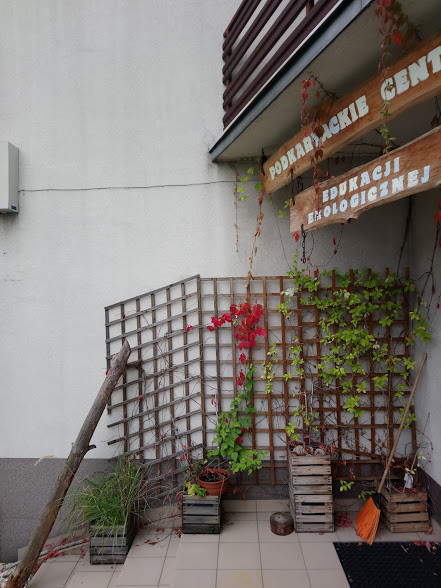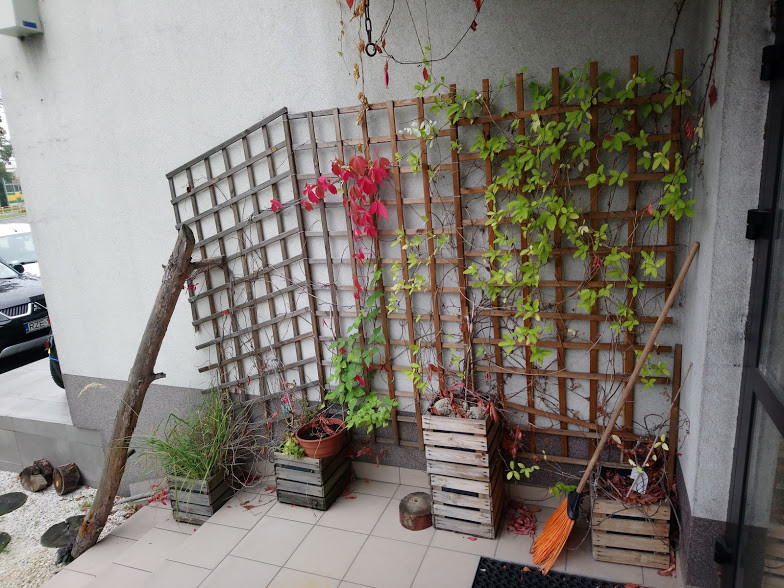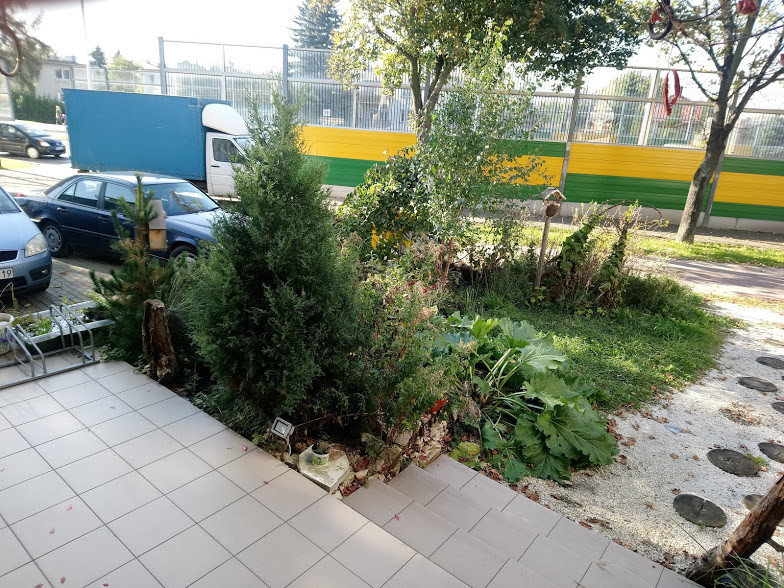Polish speaking guide 20
Compounds such aswielokulturowy, różnorodny
Compound adjectives such as wielokulturowy, różnorodny consist of two parts, where the first adjective defines the second.
Wielokulturowy means “composed of many cultures”. And similarly:wieloreligijny (many religions),
wielobarwny (many colours),
wieloznaczny (many meanings, i.e. ambiguous).
Różnorodny means “composed of different elements”. And similarly:różnokolorowy, (different colours),
różnojęzyczny (different languages),
różnokształtny (different shapes).
The active participleThe passive participleThe present participleThe perfect participleType: -ący,
-ąca, -ące
będący urzekający idącyType: -ny, -ty
zbudowany
zamieszkany
położony
otwarty
zamknięty
umytyType: -ąc
będąc zwiedzając jadącType: -wszy (after a vowel), -łszy (after a consonant)
zwiedziwszy
dowiedziawszy się
powiedziawszy poszedłszy
dobiegłszyFormed from imperfective verbs only. Inflects like adjectives.Formed only from transitive verbs, i.e. those that can be used in the passive. Inflects like adjectives.Formed
from imperfective verbs only. Uninflected.Uninflected, used mainly in writing. Formed from perfective verbs only.
The perfect participle – an impersonal verb form which describes an action previous to the one expressed by the predicate.
These participles are formed from perfective verbs only; precisely speaking, from the 3rd person masculine of the past tense.
After a vowel the ending -ł changes into -wszy, e.g.kupił – kupiwszy, and after a consonant into -łszy, e.g.poszedł – poszedłszy.
Zwiedziwszy zamek, warto przejść się uliczkami Starego Miasta.
Przeczytawszy gazetę, Piotr wyszedł na balkon i podlał kwiaty.
Zjadłszy zupę, skosztowali regionalnych przysmaków.
Expressions such as:
Europa Środkowo-Wschodnia / Środkowowschodnia
In the case of such names, spelt here with a capital letter at the beginning (name of a region), the second element consists of the adjectives środkowy and wschodni, connected by the interfix o. The hyphen indicates that the meaning of both elements of the compound is equal, and carries a different sense than the expression Europa Środkowowschodnia. In the former a hyphen replaces the conjunction i, which means that we are referring to the countries of Central, as well as Eastern Europe. However, the spelling without the hyphen denotes the countries situated in the central part of Eastern Europe.
The same rules apply to other adjectival compounds, e.g.czerwono-czarny, biało-czerwony (composed of two colours) butszaroniebieski (blue with a hint of grey), jasnozielony. In case of compound adjectives it is important to remember that only the second element is inflected.
Synonymous expressions:
na północy i wschodzie (Polski),
w północno-wschodniej (Polsce)
When determining the geographical situation of a place, we can use two synonymous structures. The first, already known to the users of this self-study book, is composed of the preposition na and the nouns północ and wschód in the locative case. Proper names always appear in the genitive (e.g.na zachodzie Francji, na południu i wschodzie Rosji). In the other structure with identical meaning, it is necessary to use the preposition w and an adjective (or a compound adjective) in the locative, followed by a proper name, also in the locative (e.g.w zachodniej Francji, w południowo-wschodniej Rosji).
ompound adjectives such as
XIX-wieczny / dziewiętnastowieczny
Such compounds consist of an ordinal number (from 11 to 20) and the adjective wieczny, connected by the interfix o. They are synonymous with participial expressions, e.g.
pochodzący z jedenastego wieku,
zbudowany / założony w jedenastym wieku.
Administrative division
The administration of Poland is subdivided into three levels: province (województwo), county (powiat) and municipality (gmina). The names of administrative units are written in lower case:województwo małopolskie, powiat poznański, gmina Sandomierz (upper case here because it is a city name).
Regions
The names of Polish regions can be nouns (Mazowsze, Śląsk, Małopolska) or nouns with adjectives (Dolny Śląsk, Pomorze Zachodnie). They are spelt with upper case and inflected according to the appropriate pattern of nominal and adjectival declension. When answering the questions gdzie? and dokąd? they are used with the preposition na followed by the locative or the accusative case. The names of two central regions,Małopolska andWielkopolska, are exceptions – they are used with the preposition w followed by the locative and do followed by the genitive.
Gdzie mieszkasz?
- Na Mazowszu/Śląsku/Warmii/Mazurach (loc.)
- W Małopolsce/Wielkopolsce (loc.)
Dokąd się wybierasz?
- Na Mazowsze/Śląsk/Warmię/Mazury (acc.)
- Do Małopolski/Wielkopolski (gen.)
Kashubians and others
The names of national minorities, ethnic groups and residents of a region are upper case,
e.g.Ukraińcy, Kaszubi, Ślązacy.
The names of city residents are lower case,
e.g.wrocławianie, krakowianie, łodzianie.
Declension of place names such asZakopane, Bystre, Chyżne
Place names with the nominative form ending in –e and which inflect like adjectives take the inflectional ending –em in the instrumental and locative cases. The inflection pattern:
nom.Zakopanegen.Zakopanegodat.Zakopanemuacc.Zakopaneinstr.Zakopanemloc.Zakopanem
Wrocław
Zabytkowe miasto na Nizinie Śląskiej nad rzeką Odrą; ze względu na swoje malownicze położenie nazywane jest często „drugą Wenecją”. Obok różnorodnych budowli z okresu średniowiecza, baroku i modernizmu warto zobaczyć Dzielnicę Czterech Wyznań, gdzie o wielokulturowych i wieloreligijnych tradycjach miasta przypominają sąsiadujące ze sobą świątynie: katolicka, protestancka, prawosławna i żydowska.
Łódź
Położona w centralnej Polsce Łódź pełna jest starych fabryk i eklektycznych pałaców. Tu na przełomie XIX i XX wieku rodziły się i upadały wielkie fortuny, co uwiecznili w swoich powieściach nobliści Władysław Reymont („Ziemia obiecana”) i Izrael Joszua Singer („Bracia Aszkenazy”). W latach swojej świetności Łódź była tyglem kultur i narodowości, o czym przypomina doroczny Festiwal Dialogu Czterech Kultur (polskiej, niemieckiej, rosyjskiej i żydowskiej). Dekadencki urok miasta fascynuje wielu artystów, w tym tak znanych jak reżyser David Lynch.
Sandomierz
Liczące 1000 lat miasto w województwie świętokrzyskim wyróżnia się przepięknym położeniem na siedmiu nadwiślańskich wzgórzach (stąd nazywane jest „małym Rzymem”). Urzeka niepowtarzalną atmosferą, rozmaitością widoków i zabytkową architekturą. Zwiedziwszy Sandomierz, warto wybrać się do pobliskiego Ujazdu, gdzie znajdują się najwspanialsze ruiny zamkowe w Polsce – Krzyżtopór.
Podlasie – mozaika kultur i narodowości
Najbardziej wielokulturowy i wieloetniczny region Polski, w którym żyją obok siebie Polacy, Białorusini, Ukraińcy i Tatarzy. Ci ostatni zamieszkują podlaskie wioski Bohoniki i Kruszyniany. Turyści przyjeżdżają tu, żeby obejrzeć zabytkowe drewniane meczety i mizary, czyli tatarskie cmentarze. Będąc na Podlasiu, nie wolno zapomnieć o odwiedzeniu Puszczy Białowieskiej, prastarego i unikatowego kompleksu leśnego, bogatego w rzadkie gatunki flory i fauny. Tylko tu można zobaczyć żyjące na wolności żubry.
Przełom Dunajca
Spływ Dunajcem przez Pieniny to niezapomniana przygoda i turystyczna atrakcja najwyższej klasy. Osiemnastokilometrowa trasa, którą turyści odbywają tradycyjnymi łodziami flisackimi, prowadzi przez najbardziej malownicze zakątki Pienińskiego Parku Narodowego. Przy ładnej pogodzie podróż dostarcza widoków, które dosłownie zapierają dech w piersiach.
Compounds such aswielokulturowy, różnorodny
Compound adjectives such as wielokulturowy, różnorodny consist of two parts, where the first adjective defines the second.
Wielokulturowy means “composed of many cultures”. And similarly:wieloreligijny (many religions),
wielobarwny (many colours),
wieloznaczny (many meanings, i.e. ambiguous).
Różnorodny means “composed of different elements”. And similarly:różnokolorowy, (different colours),
różnojęzyczny (different languages),
różnokształtny (different shapes).
The perfect participle – an impersonal verb form which describes an action previous to the one expressed by the predicate.
These participles are formed from perfective verbs only; precisely speaking, from the 3rd person masculine of the past tense.
After a vowel the ending -ł changes into -wszy, e.g.kupił – kupiwszy, and after a consonant into -łszy, e.g.poszedł – poszedłszy.
Zwiedziwszy zamek, warto przejść się uliczkami Starego Miasta.
Przeczytawszy gazetę, Piotr wyszedł na balkon i podlał kwiaty.
Zjadłszy zupę, skosztowali regionalnych przysmaków.
Expressions such as:
Europa Środkowo-Wschodnia / Środkowowschodnia
In the case of such names, spelt here with a capital letter at the beginning (name of a region), the second element consists of the adjectives środkowy and wschodni, connected by the interfix o. The hyphen indicates that the meaning of both elements of the compound is equal, and carries a different sense than the expression Europa Środkowowschodnia. In the former a hyphen replaces the conjunction i, which means that we are referring to the countries of Central, as well as Eastern Europe. However, the spelling without the hyphen denotes the countries situated in the central part of Eastern Europe.
The same rules apply to other adjectival compounds, e.g.czerwono-czarny, biało-czerwony (composed of two colours) butszaroniebieski (blue with a hint of grey), jasnozielony. In case of compound adjectives it is important to remember that only the second element is inflected.
Synonymous expressions:
na północy i wschodzie (Polski),
w północno-wschodniej (Polsce)
When determining the geographical situation of a place, we can use two synonymous structures. The first, already known to the users of this self-study book, is composed of the preposition na and the nouns północ and wschód in the locative case. Proper names always appear in the genitive (e.g.na zachodzie Francji, na południu i wschodzie Rosji). In the other structure with identical meaning, it is necessary to use the preposition w and an adjective (or a compound adjective) in the locative, followed by a proper name, also in the locative (e.g.w zachodniej Francji, w południowo-wschodniej Rosji).
Compound adjectives such as
XIX-wieczny / dziewiętnastowieczny
Such compounds consist of an ordinal number (from 11 to 20) and the adjective wieczny, connected by the interfix o. They are synonymous with participial expressions, e.g.
pochodzący z jedenastego wieku,
zbudowany / założony w jedenastym wieku.
Administrative division
The administration of Poland is subdivided into three levels: province (województwo), county (powiat) and municipality (gmina). The names of administrative units are written in lower case:województwo małopolskie, powiat poznański, gmina Sandomierz (upper case here because it is a city name).
Regions
The names of Polish regions can be nouns (Mazowsze, Śląsk, Małopolska) or nouns with adjectives (Dolny Śląsk, Pomorze Zachodnie). They are spelt with upper case and inflected according to the appropriate pattern of nominal and adjectival declension. When answering the questions gdzie? and dokąd? they are used with the preposition na followed by the locative or the accusative case. The names of two central regions,Małopolska andWielkopolska, are exceptions – they are used with the preposition w followed by the locative and do followed by the genitive.
Gdzie mieszkasz?
- Na Mazowszu/Śląsku/Warmii/Mazurach (loc.)
- W Małopolsce/Wielkopolsce (loc.)
Dokąd się wybierasz?
- Na Mazowsze/Śląsk/Warmię/Mazury (acc.)
- Do Małopolski/Wielkopolski (gen.)
Kashubians and others
The names of national minorities, ethnic groups and residents of a region are upper case,
e.g.Ukraińcy, Kaszubi, Ślązacy.
The names of city residents are lower case,
e.g.wrocławianie, krakowianie, łodzianie.
In Polish, there are 4 main types of verb conjugation. In all of them, the 1st and 2nd person plurals are created by adding ending -my and -cie respectively to the form of the 3rd person singulars. The 3rd person plural always take the ending -ą or -ją. However, please remember that there is a vast group of irregular verbs and that the described classification is a simplification.
Conjugation number 1 (with the singular endings: -ę, -esz, -e)
includes verbs with the characteristic infinitive ending -ować, e.g.: pracować (to work), studiować (to study), podróżować (to travel), interesować się (to be interested) and kupować (to buy). In all of these verbs, in both the singular and plural forms, the core -ow- is replaced with -uj-: pracuję, studiuję, podróżuję; pracujemy, studiujemy, podróżujemy.
The same conjugation applies to the verbs iść, jechać, chcieć (to want), pić (to drink), pisać(to write), móc (to be able), myć się (to wash oneself) and wstawać (to get up). However, note the change in the core, e.g.: pisać – piszę (-sz in all forms) móc – mogę – możesz (-g- in the 1st person singular and 3rd person plural; -ż- in all remaining forms), iść – idę – idziesz (-d- in the 1st person singular and 3rd person plural; -dzi- in all remaining forms).
Conjugations number 2 (with the singular endings: –ę, -isz/-ysz, -y/-i)
applies to verbs such as chodzić (to walk), robić (to do), myśleć (to think), lubić (to like), płacić (to pay), woleć (to prefer), musieć (to have to), uczyć się (to learn) and mówić (to speak).
Conjugation number 3 (with the singular endings: –am, -asz, -a/the so-called ‘no ending’) applies to verbs such as nazywać się, mieć, grać (to play), pływać (to swim), czytać (to read), oglądać (to watch), rozmawiać (to talk), spotykać się (to meet), umawiać się (to make an appointment), słuchać (to listen), znać (to know) and odpoczywać (to rest).
Conjugation number 4 (with the singular endings: -em, -esz, -e)
applies to verbs such as wiedzieć, rozumieć (to understand), umieć (to be able/can) and jeść(to eat).
The expressions na lewo (on the left), na prawo (on the right), obok (next to), naprzeciwko(opposite, across the street), blisko (close), daleko (far) are adverbs of location and answer the question gdzie? (where?). This question can also be answered by using the demonstrative pronouns tu (here) and tam, (there).
The pronouns ten, ta and to (this for masculine, feminine and neuter respectively) are used to identify an object located close to the speaker. For objects located further away pronouns tamten, tamta and tamto (that for masculine, feminine and neuter respectively) should be used.
Expressions such as:
Europa Środkowo-Wschodnia / Środkowowschodnia
In the case of such names, spelt here with a capital letter at the beginning (name of a region), the second element consists of the adjectives środkowy and wschodni, connected by the interfix o. The hyphen indicates that the meaning of both elements of the compound is equal, and carries a different sense than the expression Europa Środkowowschodnia. In the former a hyphen replaces the conjunction i, which means that we are referring to the countries of Central, as well as Eastern Europe. However, the spelling without the hyphen denotes the countries situated in the central part of Eastern Europe.
The same rules apply to other adjectival compounds, e.g.czerwono-czarny, biało-czerwony (composed of two colours) butszaroniebieski (blue with a hint of grey), jasnozielony. In case of compound adjectives it is important to remember that only the second element is inflected.
Compound adjectives such as
XIX-wieczny / dziewiętnastowieczny
Such compounds consist of an ordinal number (from 11 to 20) and the adjective wieczny, connected by the interfix o. They are synonymous with participial expressions, e.g.
pochodzący z jedenastego wieku,
zbudowany / założony w jedenastym wieku.




Photo gallery
Want to have your own Erasmus blog?
If you are experiencing living abroad, you're an avid traveller or want to promote the city where you live... create your own blog and share your adventures!
I want to create my Erasmus blog! →








Comments (0 comments)